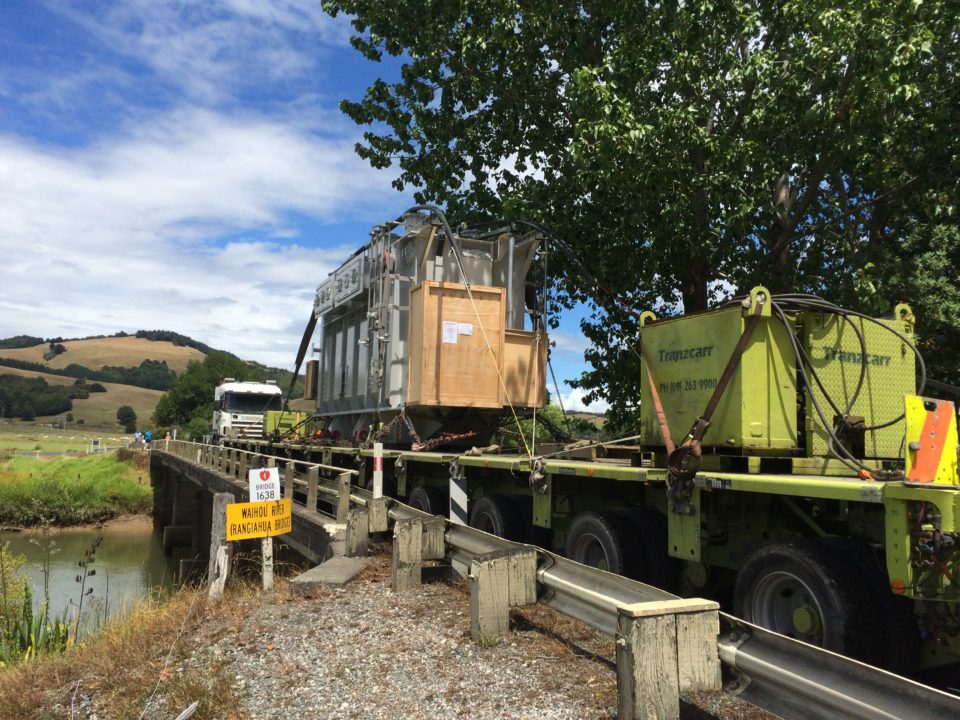It was one of the biggest loads that Northland’s winding roads could handle, yet Tranzcarr made moving Top Energy’s new transformer to site look easy. By Mary Bell and published in the April issue of Contractor.
Moving big and heavy objects is what Tranzcarr Heavy Haulage does day in and day out. Some jobs are straightforward, others somewhat complex, and some are downright tricky. Sometimes it’s the load, sometimes it’s the road, and sometimes the combination of the two that makes things interesting for the team.
In February Tranzcarr shifted an 85 tonne transformer from Auckland to Northland for Top Energy. The transformer is part of a multimillion-dollar rebuild of Top Energy’s power network in the Far North.
The road was the big factor in the complexity of this particular job. Tranzcarr had a choice of two possible routes north – either State Highway 1 or 10.
However, after undertaking a feasibility study it was very apparent that State Highway 1 was the only option.
This route would take the load, which weighed 190 tonnes all up, over the Mangamuka range, a twisting turning road with around 104 switchback corners and with sharp and steep inclines. Tranzcarr Heavy Haulage manager Mike van Ravenstein estimates grade of up to 10 percent in places.“There were a couple of pinches too,” he says.
Mike’s assessment for the load was that a 10-axle trailer (18 metres) would be the best option considering the winding road, but after working with NZTA they discovered they would need 14 axles for the bridges.“A number of the bridges north are substandard, impacting the NZ Transport Agency’s allowance for number of wheels over them.”
The solution was to use 14 axles for the first half of the trip to negotiate the bridges, then change to 10 at the foot of the Mangamuka Ranges to enable the load to navigate the bends.
Fortunately, they didn’t need to swap back to 14 after crossing the ranges and were able to continue to Top Energy without further delay.
There was a total of 16 people on the job, and a fair bit of gear: The transformer was loaded on Tranzcarr’s Goldhofer modular trailer which was powered by three prime movers – two pulling and one pushing – with a combined 1580hp.
In front was the Mack CL600 with a GVM (Gross Vehicle Mass) of 250 tonnes, then the main prime mover, a Scammell S24 with a 300 tonne GVM, and pushing from behind was a Scania 144G with a 150 tonne GVM.
In attendance were a Hiab loaded with the equipment needed to make the changes to the trailer, a 40 foot flat top carrying the gantry used to unload the transformer at its destination, a transporter with a forklift used to set the gantry up and two step decks carrying the accessory parts for the transformer.
Day one saw the unit moved out of the Ports of Auckland to the township of Mangamuka at the foot of the ranges. Just before they arrived they had to cross a one-way bridge at Rangihua that was just 3.75 metres wide. The load was 3.65 metres! Fortunately, Mike says, the approach was in their favour.
[quote_center author=””]Crossing that bridge with that load says a lot about the guys’ skills. They made it look a lot easier than it was.[/quote_center]
Day two was taken up with reducing the 14-axle trailer to 10 to make it short enough to negotiate the nasty bends on the road ahead.
Using the hydraulic jack on the trailer, they dropped the transformer onto beams and elephant stools and pulled the 14 axle unit out, removed a four axle module, and then put the reconfigured 10 axle unit back under the load. Summing it up in one sentence makes it sound straightforward, but it was an exacting and time-consuming process that took an entire day.
The next leg was the road over the steep and winding Mangamuka Range.
“This was the real challenge,” says Mike. “It’s a distance of about 15-20 kilometres that takes around 15 minutes in a car.”
Taking a set up of this length through the twisting pass was always going to be considerably slower. In the end it took 2.5 hours, and at times the procession was moving at walking pace.
An operator sitting on a seat on the trailer ensured the transformer was kept level at all times by using the trailer’s hydraulics to raise and lower various parts of the trailer as needed.
When the load finally reached the substation at the end of day three Tranzcarr used its 350 tonne capacity, four-legged gantry to unload the transformer.
The trip home was considerably faster. The trailer was broken down further into its modular parts – a total of two four-axle and one six-axle modules – and these were loaded onto the two trailers that had carried the accessory parts to Kaitaia. This tidy finish ensured cost savings for the project.
The ease with which Tranzcarr successfully undertook this job belies its complexity. A lot of planning went into it: “We started thinking about how we were going to tackle this six months out,” says Mike.
“And it was about three months from our feasibility study to completion.”
The new transformer is part of a major upgrade of the Far North’s power network.
Top Energy spokesman Peter Heath says Kaitaia’s existing transformer was bought second-hand in 1979 and developed a significant fault last year. The replacement transformer was to be operational by the end of March and is expected to work for the next 80 years.
It will convert the 110kV supply entering Kaitaia to 33kV, then feed substations at Okahu Road, Pukenui, Taipa and the JNL timber mill.
Heath says the new transformer is more modern and more efficient than the existing unit and bigger too, to accommodate growth if Kaitaia’s power demand increased in the future.

